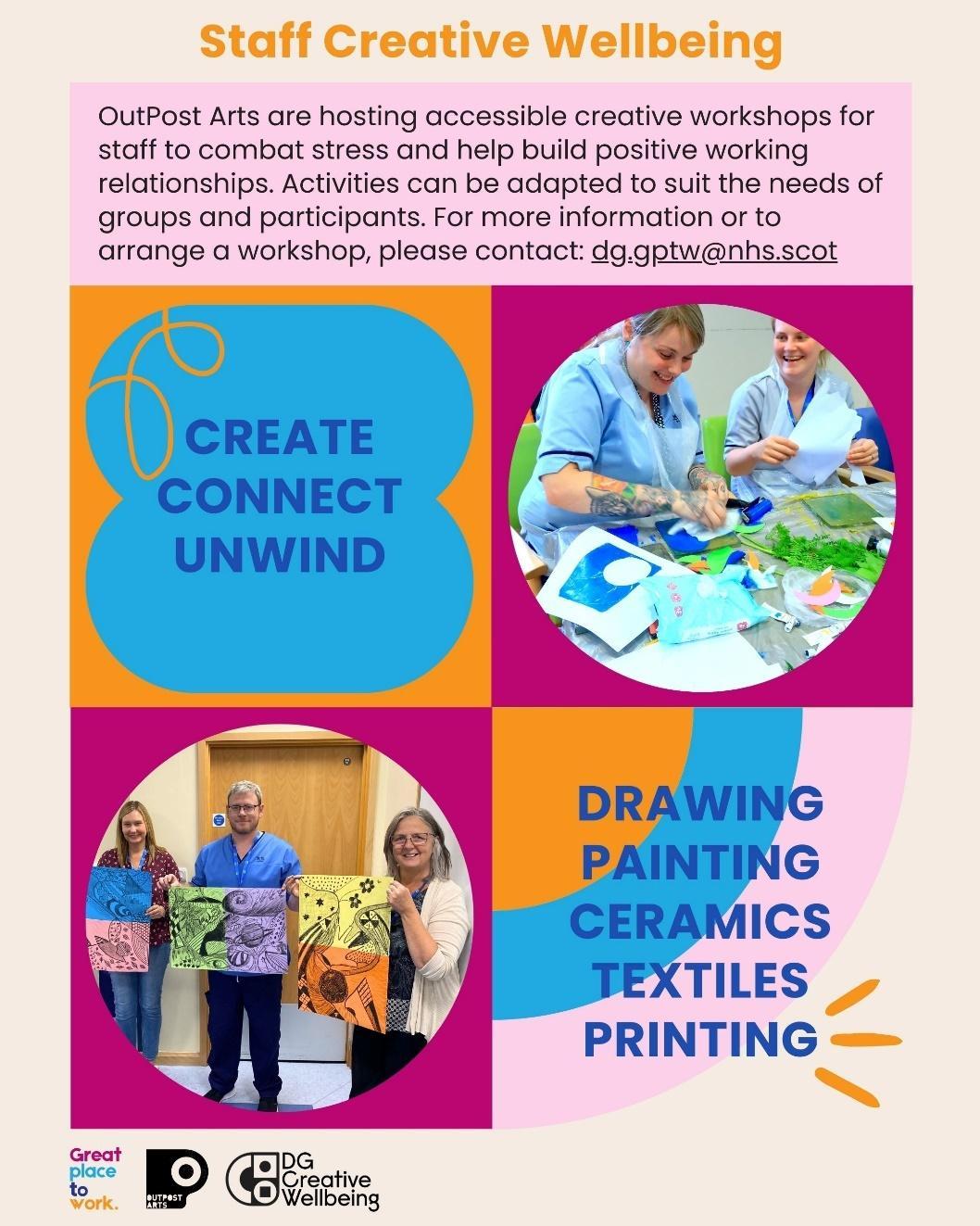

A Christmas performance at DGRI coordinated in partnership with Paragon Music – a regional arts organisation working with young adults with learning differences. Contents Executive

> EXECUTIVE SUMMARY
Based in Dumfries & Galloway. OutPost Arts is an arts organisation with three core aims - to positively affect wellbeing, education and community resilience by connecting individuals and communities with art, culture, and creativity. Following on from the pandemic, our focus has been the careful development and coordination of the wide reaching and innovative 'DG Creative Wellbeing’ project (previously titled ‘Developing Creative Wellbeing/Health’), which has been co-designed with a range of crosssector partners including schools, carer organisations, NHS D&G, adult social care and community adult and youth services.
The project features 3 pillars, with each strand delivering tailored activities that respond to specific stakeholder needs and priorities. This holistic model allows participants, people and projects across community and clinical settings to connect - reaching new audiences and gathering momentum around creative wellbeing. Crucially, the initiative has been designed to directly confront barriers including rurality, social isolation, anxiety, depression, illness, disability, carer stress, bereavement and trauma. The effects of the project have been profound for its participants, its partners and for OutPost Arts itself.
> PROJECT BACKGROUND
Following the successful delivery of a pilot adult creative prescribing project (delivered in 2020 during lockdown), with support from South of Scotland Enterprise, D&G Health Board Endowment Fund and Holywood Trust we carried out a 6-month research and development project to co-design next steps via engagement/consultation with stakeholders, scope opportunities, and form delivery/referral/strategic partnerships.
The project marked a significant step forward for creative wellbeing in D&G, with cross-sector alliances formed as a result. Through these new relationships, we accessed key participant groups, allowing us to pin-point needs, understand barriers, and create responsive programmes/activities.
Via a series of interviews, events and engagement workshops with key stakeholders, we gathered evidence/feedback which wholly supported the need to develop and embed regional strategies and creative initiatives that support health and wellbeing and promote resilience, confidence and social connection. We also developed a creative wellbeing evaluation toolkit that has guided the recording, analysis and sharing of impacts.
Read the research & development project report – HERE
> RESEARCH – Barriers to Participation
➢ Older adults feel left behind – particularly following retirement or after the loss of a partner
➢ All ages commonly experience digital exclusion, rural isolation, transport poverty, carer fatigue/stress, isolation, poverty or low income, ill health, lack of support networks, low mood/depression, anxiety, stress, grief, trauma, loneliness and hopelessness
➢ Young people struggle to maintain and forge connections (compounded by the pandemic) causing long-term effects to self-esteem, confidence and the ability to self-manage stress, depression and anxiety.
➢ All ages find online participation accessible but also desire in-person contact
➢ Disempowerment - all ages want to co-design projects
> Wider Barriers
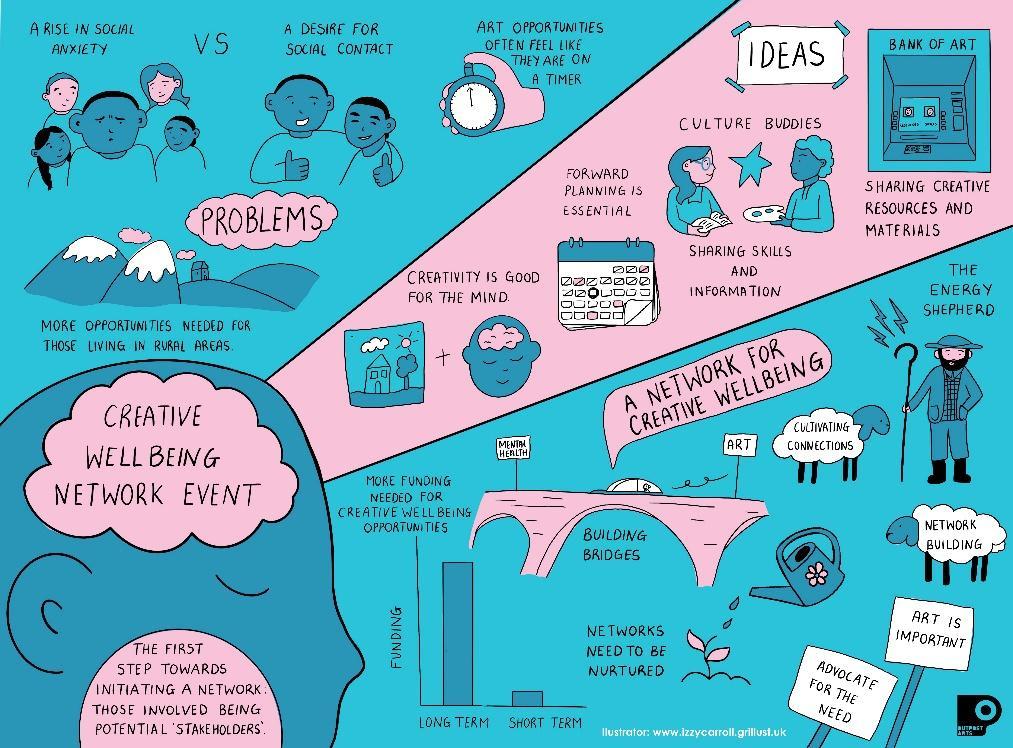
➢ General perceptions and a lack of understanding about art/culture’s health and wellbeing potential
➢ Stigma around mental health
➢ Lack of long-term funding/investment in creative wellbeing projects
➢ Lack of cross-sector/connected working & communication
➢ Tokenism & lack of participant inclusion in planning, particularly with young people
➢ Health inequalities and discrimination
➢ Lack of creative wellbeing-focused training, knowledge and resources
➢ Poor transport links in D&G
➢ Sectors not collaborating or building strategies together
Above: A scribed illustration describing feedback from a development project engagement event, highlighting barriers, ideas and opportunities.
> DG CREATIVE WELLBEING PROJECT 2023-25
Overview - Reflecting national and international movement towards the development of creative wellbeing models to prevent poor mental/physical health, DG Creative Wellbeing project develops and embeds the innovative work developed by OutPost Arts - using creativity/art as a vehicle to promote resilience, enhance wellbeing and confront health inequalities - allowing people to take control of their own lives. In the second phase, from 2025-28 we will deliver x2 18-month cycles of Art Journal & Creative Toolbox (and Graduate) projects and further develop the now year-round Satellite & Creative Wellbeing Network programmes.
DG Creative Wellbeing project has 3 ‘pillars’ -
COMMUNITY, NETWORK & HEALTHCARE.
COMMUNITY PROGRAMME: The Community programme reaches people where they live - bringing people together around a common interest - creating opportunities for wellbeing via creative expression, mindful practise, positive distraction, the development of self-management tools, and the formation of positive relationships. Participants are either self-referred (or via parents/carers) or referred in through partner organisations such as schools, mental health, social care and carer support services.
Strand 1: Art Journal Project (18+) & Creative Toolbox (11-18yold) – Watch Art Journal Project presentation HERE
In Week 1 of the community-based creative prescribing projects, which run concurrently, all participants are gifted a curated package of art suplies, symbolising an 'investment in wellness'. These contains all the materials required to take part in activities, significantly increasing accessibility for people with low/fixed incomes and ‘fast-tracking’ our participant’s progress.
Adult & Youth participants are supported by 'Community Leads' who programme online and in-person activities, commission artists, safeguard participants, and offer support/guidance - both remotely and in-person. Participants are guided by skilled Artists/Makers to embark on a creative wellbeing journey, exploring a wide variety of artistic themes, practises and processes. Participants share their progress and keep in touch between sessions via x2 secure, private social media groups. Creative Toolbox parents have their own private Facebook group which allows them to remain informed, engaged and therefore supportive of their young people.
Art Journal Project’s Part 1 focuses on the fundamentals of art journalling, working in monochrome. Part 2 investigates colour and creative research; supporting participants to reflect and share their progress. The youth Creative Toolbox has a ‘storytelling’ theme, creating narratives through a variety of artforms including visual arts, performance, costume, photography, sound design and creative writing. Participants graduate with a figurative 'toolbox' of new skills. Both projects host several creative research trips and all-day in-person sessions, enabling participants to connect on a deeper level. Adult & Youth groups share outputs via a joint public
exhibition (which forms a central part of D&G's annual Scottish Mental Health Arts Festival programme) and a separate youth showcase event ‘tells the story’ of the project using artforms explored during the programme. Following the exhibition and showcase, participants are offered a chance to join bespoke Graduate Programmes. A Peer Mentor programme was also established in 2023, and x4 Young ppl & x12 Adults received training and guidance to support the 2024 cohorts - offering feedback, encouragement, empathy and friendship. Peer Mentors are supported to explore their leadership potential and work towards achieving creative goals. x5 Youth & x12 Adult 2024 Graduates have become Peer Mentors in 2025. Our project encourages graduates to become socially engaged, empowered and active - offering paid opportunities for Peer Mentors to support participants across the wider project, including care home residents and NHS service users.



Youth & Adult community participants come together in Week 1 for a ‘Welcome Session’ – taking part in accessible activities that build confidence and break social barriers – fast-tracking positive outcomes.
Strand 2: Graduate Programme – Art Journal & Creative Toolbox project graduates have access to bespoke activities that:
Expand their practise – A digital skills programme supports participants to learn transferrable skills, access further pathways and nurture personal ambitions e.g. portfolio development, character/games design, animation, illustration, graphics. We also provide graduates with guidance and support to achieve wider creative ambitions via voluntary and paid roles.
Connect art with place – An annual public art project allows Adult & Youth community participants to come together to design an outcome that responds to the needs of specific clinical service-users and staff. In 2023 participants co-designed a stunning mural for an NHS Children, Young People and Family Centre. In 2024 they have worked with a service which supports people recovering from addiction. In partnership with The Stove Network and Historic Environment Scotland, 2024 Youth graduates have been supported to 'harvest the sounds' of Caerlaverock Castle & Nature Reserve and create narratives that will be shared with visitors.
Explore creative enterprise opportunities - Graduates are supported to explore creative enterprise opportunities, taking part in an annual public crafts event (Upland Made Makers Market in 2023, and Shambellie House Christmas Market in 2024).

Creative Toolbox graduates receiving awards at their Showcase event in 2024
Community Engagement:
80 adults and young people experiencing barriers and inequalities took part in Art Journal Project & Creative Toolbox programmes. We delivered:
6 creative research trips, supporting participants to access arts/cultural venues and gather inspiration
37 in-person sessions, allowing participants to form social bonds, and receive 1-2-1 skills-development support
57 remote sessions, supporting participants to explore a diverse range of practises and techniques

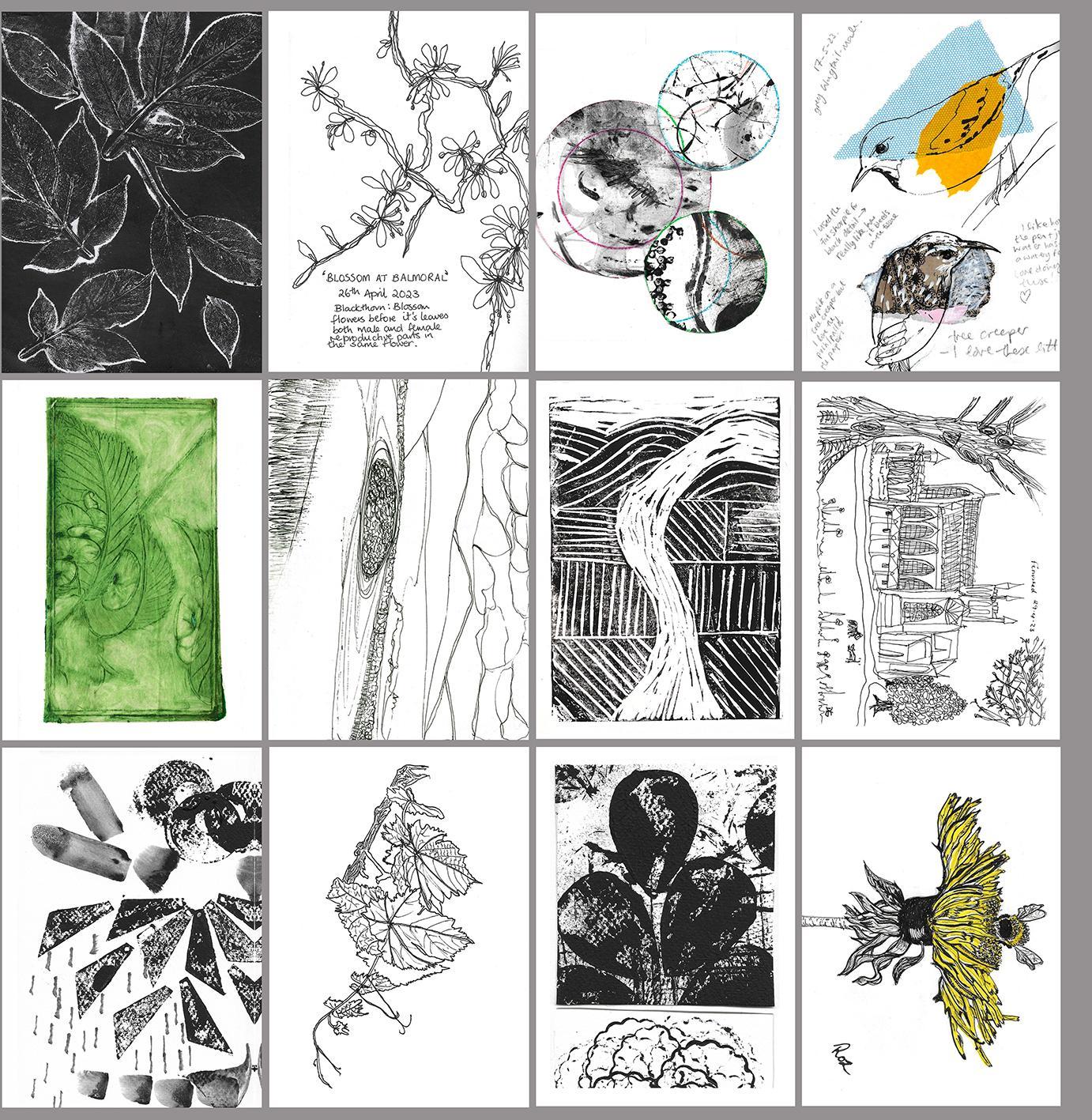
A selection of greeting cards and postcards designed by 2023 adult Art Journal Project participants as part of the Graduate Programme’s creative enterprise strand.
Project Spolight – The Mural Project
DG Creative Wellbeing project supports community-based creative wellbeing initiatives to form links with the creative health programme – delivered in partnership with NHS D&G – and The Mural Project is the perfect example of these two strands working harmoniously together; creating hugely positive impacts for participants and service stakeholders.
Each cycle, The Mural Project - part of the Community strand’s ‘Graduate Programme’ - sees adults from Art Journal Project come together with young people from Creative Toolbox to form a public art ‘collective’. The Artist Lead (Katie Anderson), alongside regional Associate Artists, support the group to work with an NHS Dumfries & Galloway site/service, connecting with its staff and service-users to develop, design and deliver a site-specific art installation. The graduates take part in a range of online and inperson sessions, developing new creative skills and knowledge around the planning and project management of a major public art project. The initiative encourages participants to literally ‘think big’, scale up their ambitions, explore new creative pathways, enhance their art skills, work as a team, build positive relationships, learn about healthcare services, and ‘give back’ as volunteers.
In Year 1, graduates collaborated with CAMHS staff and service-users to create a more welcoming and vibrant environment at their base - The Willows Children, Young People and Family Centre. This space is utilised by a wide variety of services including children and adolescent mental health teams, so it was essential that all users were considered as part of the design process. Bringing together learning from collage, printmaking and sign-writing workshops, the final creation spans a large wall in the main reception area – creating a new, welcoming focal-point for people arriving in the space. As a result of taking part in the project, x2 CAMHS service users were referred into the next cycle of Creative Toolbox, and one of these participants has graduated and become a part-time Youth Project Assistant – offering support and encouragement to the new cohort (see Case Study – Kayla).
In Year 2, graduates worked with Focus Wellness & Recovery Hub – an important facility in Lochside, Dumfries that supports adults dealing with addiction. Katie worked with the community graduates, supporting them to collaborate with staff and service-users to co-design a range of creative outcomes, including a painted bench, planters, wall murals and clay tile installation. Regional artists Alice Griffin and Chris Taylor also contributed by delivering specialist art sessions that further supported the project’s development.
To ensure the mural meaningfully enhanced the environment for staff, service-users, and visitors, Katie liaised closely with the Focus Hub team and service-users, ensuring their ideas and reflections were woven into the final design, which featured colourful, abstracted landscapes and nature motifs that symbolise healing – challenging the stigma often associated with addiction.
The resulting artworks creates a warm, uplifting and welcoming environment for everyone using the space, from the point of entering the building and into the reception and waiting areas.
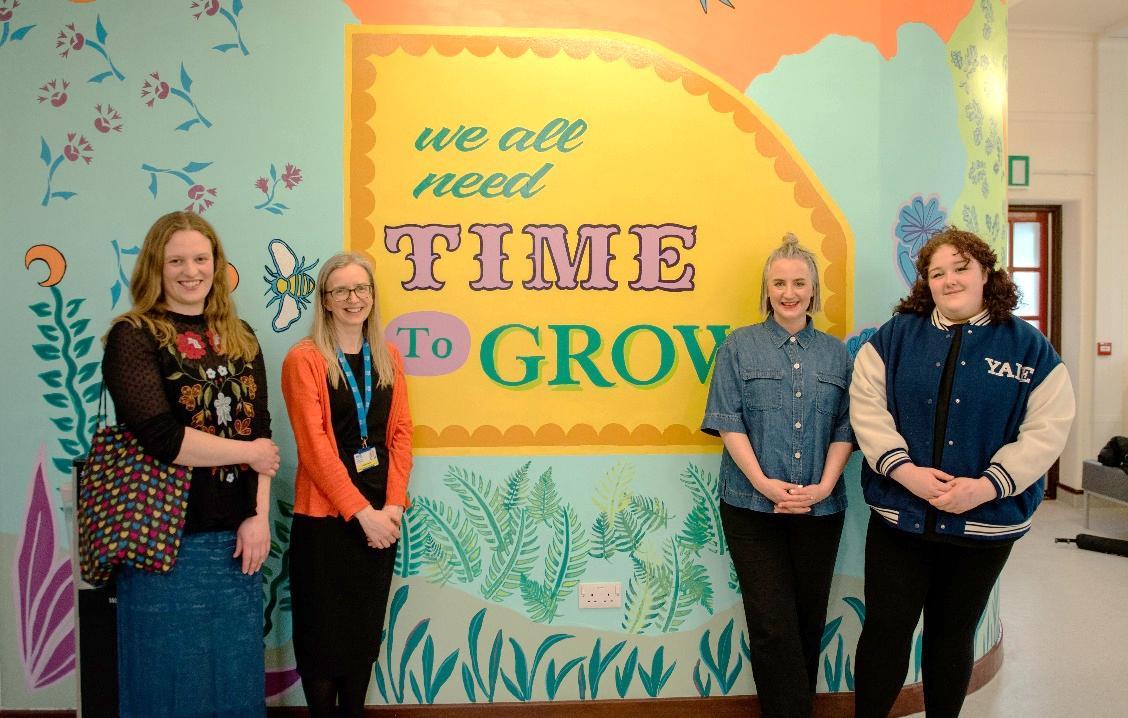
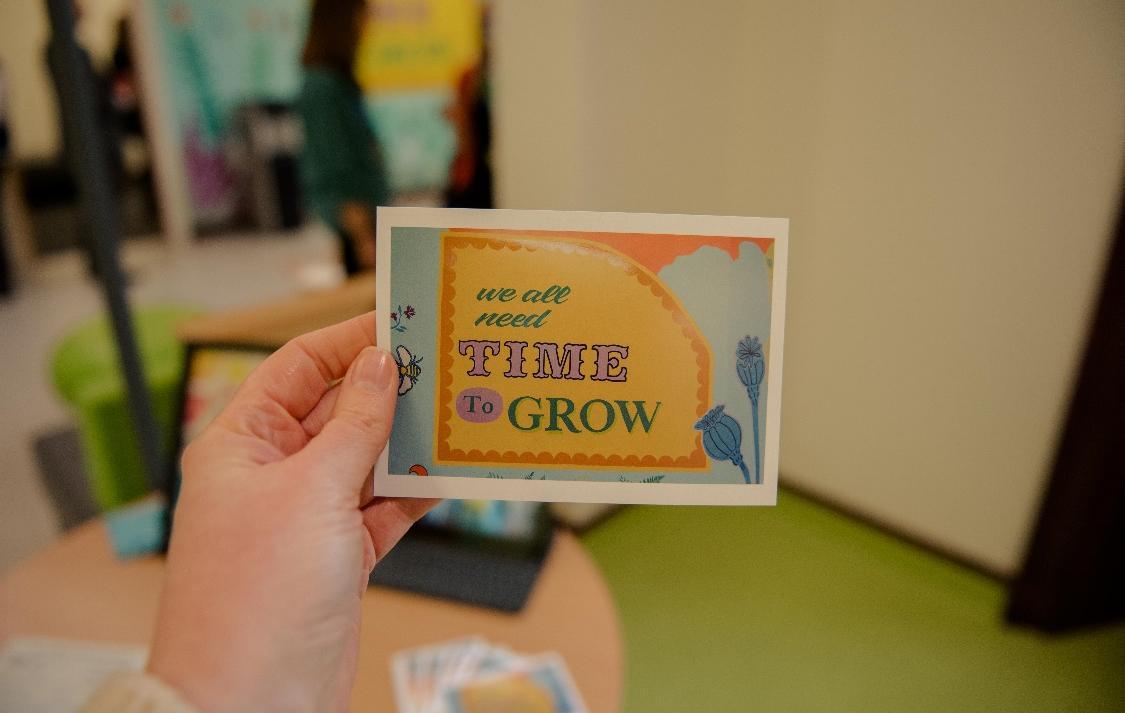


Community – Youth Case Study: Kayla
We have heard powerful stories of transformation from community participants including Kayla - a 17-year-old struggling at school, dealing with severe social anxiety and isolation. Having identified an interest in Art, Kayla was referred into the Youth Programme by CAMHS. Kayla has since become a Peer Mentor, displaying a natural ability to help others. OutPost Arts has continued to work with Kayla to explore her potential, creating a part time position for her to support in-person sessions – providing work experience.
“For me I never really did anything within a community setting due to my social anxiety. Speaking to new people is quite scary, but this has pushed me out of my comfort zone and allowed me to speak with cool and interesting people that I would have never had the chance to meet without being a part of this project… it gave me the chance to meet new like-minded people and allowed me to learn more skills which will help me in the future. I feel like I have grown in confidence and more doors have opened for me by getting involved. I really do appreciate it and think it has made me a better person. I’m a lot more social. I think because I’ve been working with OutPost Arts for a while now – before that I could barely speak. Some days I couldn’t speak to anyone” - Kayla



2023 youth participants taking part in one of two creative research trips – in Edinburgh they visited cultural hubs and together, made a short film at Sky Studios.
Community – Adult Case Study: Jackie
Having survived breast cancer – which has caused chronic pain and tiredness - Jackie experienced a bereavement 7 years ago. On the heels of this loss, she became a carer for her elderly mum. The Covid pandemic, combined with the family issues she was facing, had caused her to feel low and anxious, negatively affected her self-esteem. Having found that creativity had previously supported her wellbeing, Jackie signed up for Art Journal Project. She had hoped that by participating in an immersive creative programme, she would begin to feel more positive and confident in herself. She couldn’t commit to an academic art course because of her caring responsibilities, so the option of participating in a guided, accessible and inclusive programme that takes barriers into account felt like the perfect solution.
As a direct result of taking part, Jackie has found it easier to embed creative self-care into her daily/weekly life, her creative skills have blossomed, she has made friends with a supportive community of like-minded people, and new opportunities have emerged that previously didn’t seem possible. Jackie has taken part in Peer Mentor training, and is currently supporting the 2025 cohort. She is exploring self-initiated creative enterprises including creating and has published her very own desk-calendar. OutPost Arts has also recently commissioned Jackie to support artists at Midpark Hospital to deliver patients and staff creative wellbeing sessions.
“I loved the AJP programme – I felt so lucky that we were getting all the attention and help with everything, and all the materials were free and great tuition. Great input from the artists and programme leaders. The Facebook support was amazing and really encouraged me. It all really felt so accessible and easy, also so flexible with the recordings and pdfs…no problems if I couldn’t make a session because of caring responsibilities or being away as I could catch up.
Right from the beginning it had an impact when we had to do doodling/continuous line drawings every day - I combined it with a short walk first thing in the morning – it helped me get my head straight and definitely made my really stressy life at the time feel a bit calmer and helped me cope better with my day.
The Mural project was one I didn’t feel confident about, but it was the one I enjoyed the most – I thought the artist lead was fantastic - so encouraging and inclusive of everyone no matter what their skill level. I enjoyed everything about it and felt really included and proud to be part of making such a lovely wall in a health/community setting.” - Jackie

Jackie on an Art Journal Project trip to Glasgow. The group trips have allowed her to build meaningful relationships with other participants which she has maintained independently, creating a supportive network.
Strand 3: Satellite Programme –
Satellite Programme features a broad spectrum of creative wellbeing projects across D&G which are centered in partnership working. We have collaborated with Upland CIC to develop ‘Made WELL’ – an annual initiative that underlines the important connection between crafts and wellbeing – enhancing an annual ‘Upland Made’ event with a programme of arts + crafts workshops, encouraging a mixed demographic to learn about creative wellbeing through hands-on, participatory making.
In 2023, we partnered with D&G Carer's Centre to deliver ceramic workshops, allowing service-users to express themselves and develop new skills/awareness regarding self care. OPA have also developed a pilot ‘Care Project’ with Scottish Care. Phase 1 of the project engaged residents and stakeholders, co-designing a series of creative sessions exploring visual arts and music with movement. We commissioned Associate Artists and partner organisation Paragon Music to lead the sessions, which were extremely popular with attendees, resulting in an agreement with Scottish Care to develop the project further from 2025 onwards – hopefully leading towards embedding creative wellbeing activities and initiatives across large numbers of D&G’s care homes.*
*Please see the Care Project report for further information.


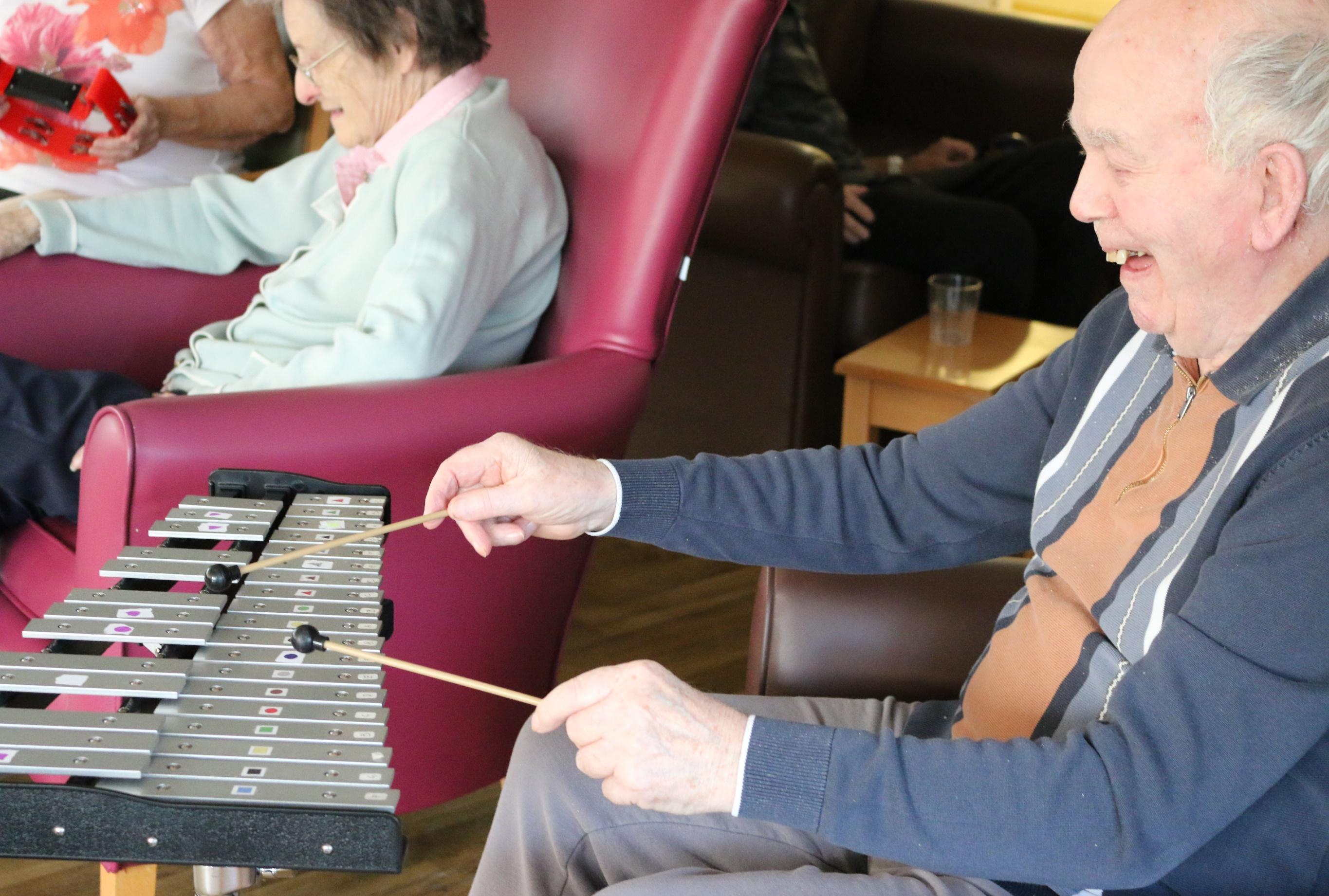
The Care Project allowed residents and staff to engage with regional creatives and experiment with a range of art practices including music, movement, collage, drawing, painting and writing.
CREATIVE WELLBEING NETWORK PROGRAMME:
The cross-sector network delivers a range of outcomes across three priorities - Amplify, Connect & Cultivate - hosting a range of remote and in-person gatherings, engagements and events for stakeholders and partners. The network underlines the powerful connection between the arts, culture and wellbeing via its creative programme – commissioning work and hosting events/activities that explore creative wellbeing-related themes and connect people/organisations.
The network creates access points, supporting regional artists and organisations to take part in annual creative wellbeing related initiatives such as ‘Scottish Mental Health Arts Festival’ and ‘Healing Arts Scotland’. The network has taken a lead role in developing and amplifying a regional ‘Manifesto for Creative Wellbeing’ which aims to raise awareness at all levels around art and culture’s powerful potential for healing, health and wellbeing, and lobbies for increased investment and inclusion in strategic planning at regional and national levels. Moving forward, the network will play a central role in the new Cultural Partnership for D&G.
LINKS: MANIFESTO FOR CREATIVE WELLBEING | SYMPOSIUM REPORT | SYMPOSIUM PLAYLIST
The Symposium, supported by the Regional Cultural Fund, was launched at OutPost Arts’ inaugural ‘D&G Creative Health & Wellbeing Symposium’ held in February in Dumfries – the first of its kind in our region and a significant marker for the progress that has been made to increase connections between the arts, culture, health and care sectors following on from the pandemic.
The aim of the Symposium was to:
➡ AMPLIFY regional creative health and wellbeing activities and initiatives
➡ SPOTLIGHT examples of good practise in the creative health and wellbeing ‘space’
➡ CONNECT local, regional and national stakeholders’
➡ EXPLORE opportunities to embed work, increase investment and enhance learning
➡ SHARE research, strategies, knowledge and testimonies that underline art and culture’s powerful connection to health and wellbeing
The event - opened by remarks from Valerie White (Director for Public Health, NHS D&G) and Marion Bain (Interim Deputy Chief Medical Officer, Scottish Government) - brought together a range of cross-sector speakers and delegates. Attendees gathered for breakout sessions to discuss the Manifesto’s six themes through the lens of three key delivery strands – Community, Youth and Healthcare, followed by a panel Q&A session. The programme also featured two stunning performances from regional artists which drew attention to the range of local talent. A Symposium report will be published in early June 2025.




The Creative Wellbeing Network has engaged a diverse range of regional and national stakeholders to contribute to the overall project’s strategy, collaboratively defining its aims, objectives and priorities

ART-IN-HEALTHCARE PROGRAMME: Supported by NHS D&G Charity and delivered in partnership with NHS D&G
The Art-in-Healthcare programme enhances the patient, staff and visitor experience across X4 main sites via x3 delivery strands –
Participatory Programme – Participatory programmes include embedded, regular creative workshops with staff and patients. Example - Midpark Hospital treats people requiring acute mental health support, and embedded, regular sessions create meaningful opportunities for positive distractive and creative expression; encouraging participants to connect with their creative selves, and build confidence through skills development and output-sharing (via exhibition programme).
Events & Exhibitions – OPA coordinates a lively and inspiring programme of exhibitions, performances, and experiences across four clinical sites, creating opportunities for artists, creative producers, community-based groups/organisations and other regional and national partners to share artwork in clinical spaces, and connect with wider diverse audiences. The exhibition programme also supports patient healing, recovery and promotes staff wellbeing – transforming clinical sites into welcoming spaces.
Enhancing Spaces – Improving the patient, staff and visitor experience of healthcare sites through creative interventions, actions and outputs, the Enhancing Spaces programme creates meaningful outputs that allow people to feel at ease, inspired and supported – from murals to 3D installations, the programme responds to the specific needs of the people using or working in key healthcare spaces.


> ENGAGEMENT
From Jan 2023 - Feb 2025, the umbrella DG Creative Wellbeing project (the Community, Network & Art-in-Healthcare programmes combined) has:
➢ Supported 1348 people across community and clinical participatory programmes, enabling them to engage with the arts and harness creativity as an agent for transformation.
➢ Supported 439 NHS D&G staff to directly engage in Art-in-Healthcare programme activities and projects.
➢ Held creative health and wellbeing events attended by over 600 people.
➢ Hosted exhibitions which have attracted audiences of over 30,000 people.
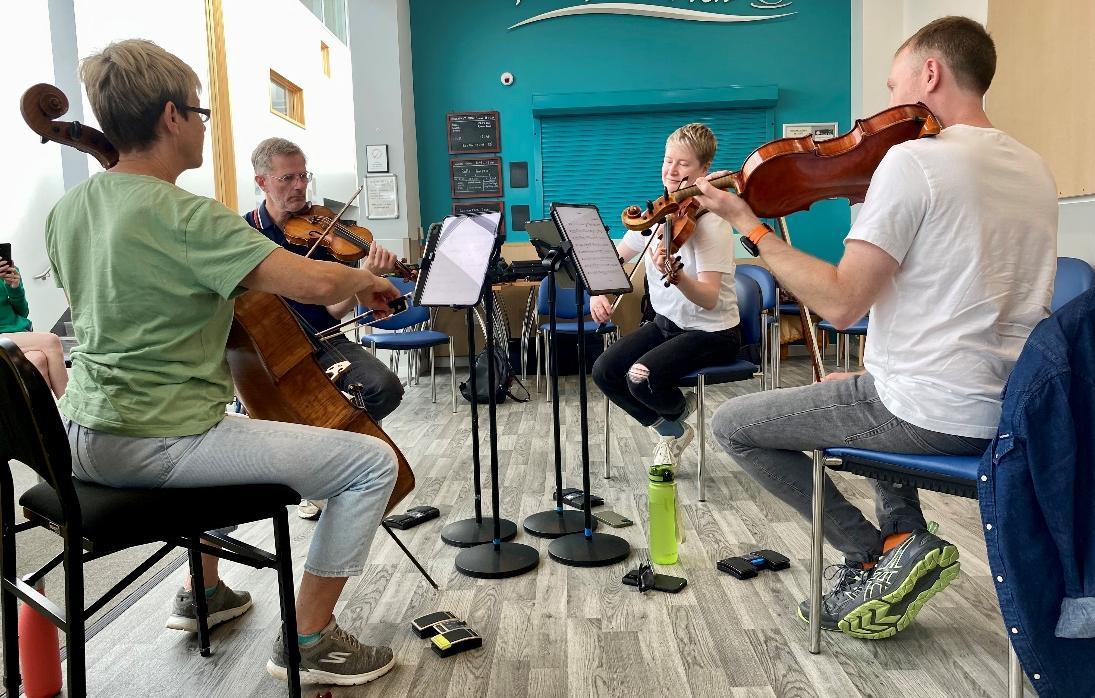
Widening engagement and capacity through partnership working…
> Scottish Ensemble & DG Arts Festival
Our partnership with DG Arts Festival and Scottish Ensemble allowed the Art in Healthcare programme to host a ‘Music for Wellbeing’ session for Midpark patients and staff, supporting participants to benefit from a reflective listening experience (left).
> Shambellie House & Upland CIC
Our partnerships with regional cultural organisations such as Shambellie House and Upland CIC have added value to the Art in Healthcare’s exhibition programme, bringing high quality local artists’ work into clinical spaces which supports wellbeing and enhances the patient, staff and visitor experience.

As part of a ‘Wellness Day’ initiative, staff members explored printmaking techniques and took part in creating a window mural.
Project Spotlight – Midpark Hospital Workshops
Blocks of regular, fortnightly creative workshops consistently provide a positive, mindful distraction from hospital routines, fostering social connection and creative self-expression. Patients and staff share materials, ideas, and encouragement, creating a warm, supportive atmosphere that allowed them to step outside of their roles and connect as fellow creatives. Patients described sessions as “really therapeutic” and “so much fun,” noting how the experience have helped reduce anxiety and inspired new hobbies. Patient participants have also shared that the sessions help prevent self-harming through positive distraction.
The sessions create an opportunity for peer support and encouragement, and by learning new skills, their confidence and selfesteem was boosted. By creating an exhibition space in the public atrium area – where the workshops now take place –participants confidence is heightened by sharing outcomes with an audience. The displays also enhance the hospital, providing an uplifting, welcoming and vibrant focal point in the Atrium, beside the café and reception areas.
Our team is working closely with Midpark teams, particularly Occupational Therapists, channeling learning from the sessions into the hospitals’ staff-led, weekly activities programme, and we will continue to build on this relationship by developing staff mentoring opportunities. OPA’s creative team also meet regularly with OT team members to evaluate progress.




Midpark Hospital’s Atrium’s new exhibition space shares work created by patients and staff produced via regular creative wellbeing sessions.
Q: Why do you think creative activities are particularly beneficial for patients receiving inpatient care?
A: I think creative activities are innate, we seek them out from childhood. We learn about the world through them, access our senses through them, make friends through them. We use them to relax and switch our minds off or to stimulate our thinking with ideas and new connections. We should never stop creating - and if we find ourselves in a place where creativity is missing or has become a forgotten part of us, we’re likely missing out on a vital balance of experiences in life. Those are the times when we might need a bit of help or simply an opportunity to reconnect with creativity, because it’s so important, for so many reasons. It’s hard to fully capture in words the emotional, social, physical and cognitive impact of creative activities, but the research doesn’t lie - being creative is good for us.
Q: How have the sessions delivered by DG Creative Wellbeing influenced your team's approach to embedding creativity into inpatient care?
The Creative Wellbeing sessions have had a big impact on all the staff who have attended - not only the Occupational Therapists, who’ve been learning new techniques and experimenting with new materials, building confidence in the creative activities we offer - but also the nursing staff who’ve taken part.
Below: Caroline’s ‘empowering’ self-portrait, created at a Midpark workshop to promote positive self-image.


We’re all learning together, in collaboration with individuals from the wards, sharing the experience and being part of something meaningful. It’s been a fantastic journey so far, and when you have that kind of positive experience, you’re much more likely to do it again.
Q: How have the sessions delivered by DG Creative Wellbeing influenced your team's approach to embedding creativity into inpatient care?
A: The DG Creative Wellbeing sessions have had a big impact on all the staff who have attended - not only the Occupational Therapists, who’ve been learning new techniques and experimenting with new materials, building confidence in the creative activities we offer - but also the nursing staff who’ve taken part. We’re all learning together, in collaboration with individuals from the wards, sharing the experience and being part of something meaningful. It’s been a fantastic journey so far, and when you have that kind of positive experience, you’re much more likely to do it again.
Q: In what ways have the ideas and feedback from those initial sessions helped shape your own programme of workshops?
A: Because the sessions regularly gathered feedback, we were able to revamp our own groups to include multiple wards and shared environments.
It made us more responsive to what people wanted and actually helped us push the boundaries of our own service. We now regularly run an evening group - outside of traditional 'core hours' - which has brought multiple benefits, giving individuals access to therapeutic activity at a time when many of us would naturally engage in creativity ourselves.
Q: What kind of response have you seen from both patients and staff since introducing these regular creative sessions?
A: These regular creative sessions have had a real impact. The group has grown with each session, and we’ve seen up to 20 participants at a time - that’s about a quarter of the hospital! Having the sessions be intergenerational has also opened opportunities for collaboration and created social spaces that aren’t typically available, forging friendships across different age groups. The key is that everyone who attends wants to be there and that makes it all the more meaningful and enjoyable. We’ve even had Occupational Therapy staff come in on their days off to take part and nursing staff have swapped shifts just so they can attend too!
Q: Could you tell us more about the exhibition space and what it means for patients to have their work displayed publicly?
A: Initially, there was definitely some anxiety around agreeing to have work shared and understandably so. Creativity is personal and no one is ever expected to share anything they’re not comfortable with. That said, now that the display is up in the hub area of the hospital, I’ve had the privilege of witnessing a few individuals' reactions in real time when they saw their work on display for the first time. Not one reaction has been negative. Each time, it’s started with surprise, followed by excitement or disbelief that their work is up on the wall, brightening the space and then, most beautifully, pride, as they share that achievement with others.
Q: What does a long-term, sustainable approach to creativity in mental health care look like to you?
A: I believe the Cultural Partnership and the Creative Health manifesto are highlighting some really important points and establishing a clear vision for creativity in the region. While sustainability remains a challenge across all organisations, the message is clear: collaboration is key. Dumfries and Galloway is rich in culture and heritage, with a strong history in mental health care at the Crichton Royal Hospital, where care was centred around visual arts, nature, music, drama and literature. We must work together with community partners, health and social care organisations, and most importantly, truly listen to the voices of lived experience to ensure that creativity’s impact on quality of life, health and wellbeing is embedded in mental health care - long before, during and after any hospital admission.

